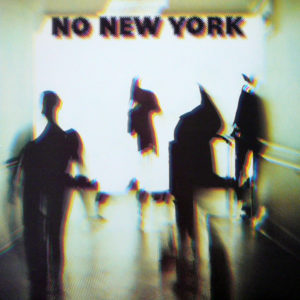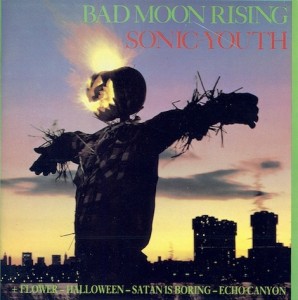Beginner’s Guide: No Wave

There’s no question that a lot of people have heard of no wave, but even more than 35 years after the movement’s peak, it’s still a period of music history that’s talked about more than listened to. And it’s not hard to understand why—this isn’t music that’s all that easy to listen to. It’s noisy, discordant stuff, made of feedback and alternate tunings and pure noise in some cases. It’s not pop, it’s art. And not even pop art, really; some of the best no wave albums feel more like installations than the type of songs that are meant to be played on stage, in front of writhing, shimmying bodies.
But no wave, despite all its airs and pretenses, is built from a pop foundation. The essence of no wave is in its aversion of expectations. Where the punk and new wave movements—arguably one and the same—took a familiar pop formula and added speed and volume, no wave’s players deconstructed the idea of a pop song and pulled it apart in curious ways. With The Contortions, it became nervous approximations of dance songs, covered over with atonal sax bleating. With Mars, it became primal scream therapy with occasional melody. And with Swans, it became a persistent, menacing grind. But while no wave ultimately became an umbrella statement for different variations on a similarly dissonant aesthetic, no two no wave bands were the same.
A lot of no wave releases have been subject to reissues of late, including notable albums by Swans, Sonic Youth, Lizzy Mercier Descloux and more. So this seems like an opportune time to dive into what makes no wave what it is, and what’s interesting about that. The number of releases is limited, and the number of easy-to-find releases even more narrow, but obscurity aside, it’s a genre well worth trying to decode, no matter how futile an effort that might be. So dive into this guide to five of the best no wave albums, and see what feedback-laden rabbit hole it sucks you down.

Various Artists – No New York
(1979; Antilles)
Any and all awareness of no wave, outside of a small group of weirdos in the ’70s in New York, can be attributed pretty much directly to No New York. A compilation of 16 tracks by four bands on two LPs, it’s about as concise-yet-comprehensive a document as you’re likely to find of the scene, compiled and produced by none other than Brian Eno (who had seen each of these bands and immediately wanted to document the strange musical happenings that he saw). It’s a strange comp, and one that doesn’t make any concessions toward being accessible—just look at that super-creepy shadows-in-a-hospital album artwork. Each of the four bands here presents a different aspect of the discordant, abrasive, messy and sometimes primitive nature of the no wave aesthetic. The first of the four, The Contortions are perhaps the most accessible, marrying punk to disco and free-jazz in a way that comes across like Devo jamming with Ornette Coleman. It’s amazing, but it’s also confrontational in a fascinating way. The grooves are undeniable, but James Chance’s saxophone is practically weaponized—more on that soon. Teenage Jesus and the Jerks, fronted by singer and performance artist Lydia Lunch (who sounds a bit like Patti Smith opening up a wound), is darker and noisier, with her poetic moaning backed by guitars that wrap around each song like a gauze of broken glass. It’s horror soundtrack as punk songwriting. Mars is the third band on the lineup, their manic shrieks and woozy detuned guitar murk making them sound less like a proper band and more like a primitive cult beating their instruments in some kind of horrific ceremony. DNA, by comparison, is a much sleeker, simpler outfit. Which isn’t to say they’re a more tuneful band—they have grooves, but they’re not grooves as pop music would have us understand them. They come in the form of atonal chugs or tense, shrieking riff rhythms. It’s surreal and seductive all at once. In fact, that pretty much goes for no wave as a genre unto itself.

Contortions – Buy
(1979; Ze)
James Chance and the Contortions were the most immediate band featured on No New York, and if we’re not counting Swans or Sonic Youth—which we shouldn’t, since they only embraced greater accessibility after the no wave era ended—they were also the most approachable of the genre as a whole. A bizarre and dance-friendly take on punk with more than a few nods to the likes of Captain Beefheart, The Contortions’ debut album Buy is an itchy and jittery alternative to new wave icons like Television, whose music isn’t as far away from the skronk-boogie of James Chance’s as one might be led to believe. Sure, this is less overtly melodic, thanks in large part to the squealing sax provided by Chance, himself. But the rhythms, in particular the shimmy-shake basslines from David Hofstra, make it damn near a hits collection by no wave standards. Listen to “Contort Yourself” and try not to follow Chance’s instructions to “distort your body and twist your soul.” There’s a similar immediacy to “I Don’t Want to Be Happy” and “Throw Me Away,” and by and large, it’s an album that places as much of a priority on fun as it does art.

Glenn Branca – The Ascension
(1981; 99)
If The Contortions represent the most pop-oriented elements of no wave, then Glenn Branca is much farther down on the avant garde spectrum. More than a songwriter, he was a composer and an experimental visionary. He conducted ensembles of electric guitars as if they were orchestras, all of them treated and tuned to yield a certain sound and texture. The Ascension, an album comprising five such pieces, featured an ensemble of four guitarists—including Branca himself and Sonic Youth’s Lee Ranaldo—along with a bass player and a drummer. But these aren’t pop songs by any stretch. Some are a little more accessible, like the weirdo groove of “Lesson No. 1,” while others, such as “The Spectacular Commodity” or the title track (each of which runs about 13 minutes long), are abrasive and terrifying works of intricate and tense composition. Guitars no longer sound like guitars, but rather like bells ringing in a gothic cathedral. And in “The Ascension”‘s most beautiful moments, it suggests shoegaze more than half a decade before it began to surface. It’s a work so ahead of its time, I’m still not sure if we’ve caught up yet.

Sonic Youth – Bad Moon Rising
(1985; Blast First)
No wave didn’t make stars of anyone. It was, however, the launching ground of quite a few notable careers, including DNA’s Arto Lindsay, would would make a long career out of experimental pop records, as well as Bill Laswell, whose name was on any number of notable pop/rock/art records of the ’80s and ’90s. The one major exception here is Sonic Youth, who didn’t actually become legends because of no wave, but it’s where their long and constantly shifting story begins. The no-waviest of their releases is their 1982 self-titled debut EP, but the peak of their no wave powers was 1985’s Bad Moon Rising, named after a Creedence Clearwater Revival song and conceptually bound by a dark and fucked-up interpretation of Americana. It’s their most terrifying album by a good margin, which is kind of true of any no wave album, really. But Sonic Youth was on the verge of breaking into another realm of artistry here—the stunning Evol and Sister arriving one and two years later, respectively—and you can hear the brilliance in these tortured, menacing tracks. There is one song that kind of, sort of masquerades as a hit, though—”Death Valley ’69,” featuring Lydia Lunch. It’s a Manson Family death disco that’s danceable and nightmarish all in one package. This is no wave hitting several extremes at once.

Swans – Filth
(1983; Neutral)
So, here’s something funny. A couple years ago, I wrote up a Beginner’s Guide to Swans, but I didn’t include their debut album Filth in my list of essential starting points. And that has more to do with the long arc of the band’s career, which curves toward a dark, but ultimately melodic presence. Filth is ugly and atonal and messy and menacing. It’s also very, very good, just not necessarily an ideal starting point for someone to make sense of Swans, particularly since they haven’t released an album that sounds much like it in nearly 30 years. But it is a strong starting point for those diving into the twisted world of no wave. Michael Gira is less of a Cave/Cash-style gothic crooner and more of a barking, feral animal, shouting monosyllabic phrases in a percussive fashion. The band’s thumping bass and shrieking guitars make Filth almost more like an industrial release, but if you slide some of these tracks in between those of No New York, it fits perfectly. But what really sets this apart from both Swans records and no wave standard bearers is its groove—you can dance to these songs, however harsh they might sound. How you dance to them is a different story.
Also recommended: The most immediate problem with no wave is that so many of the releases under the “no wave” umbrella are out of print. So it’s easy to recommend stuff that’s noteworthy or interesting, but not everything is so readily available. Here’s a few that are: Sonic Youth’s Confusion is Sex is a logical next step after the creepy drone-rock of Bad Moon Rising; Lizzy Mercier Descloux’s dance-punk-funk weirdness debut Press Colour has been reissued by Light in the Attic, so definitely seek that out; and Lydia Lunch’s 13.13 is an excellent meeting place between no wave’s experimental avant-gardism and goth-rock’s moody hedonism.
Advanced listening: At this point, you’re dealing with releases that are a bit more complicated to track down, but if you’re this deep into the discovery phase, you might be willing to put down some cash for some rare vinyl. And in that case, there’s no need to hold back. Glenn Branca was, in addition to being an accomplished avant garde composer and innovator under his own name, a member of Theoretical Girls, and 2002’s Theoretical Record is the most complete collection of recordings by the band. James White and the Blacks is an alias of James Chance and the Contortions, and Off White is their collection of disco-flavored tracks, including a more dancefloor-engineered version of “Contort Yourself.” And for something a little different, try out Massacre’s Killing Time, featuring Bill Laswell and drummer Fred Maher (The Voidoids) taking on some progressive noise rock sounds. Good stuff, if you’re willing to make the dig.
Jeff Terich is the founder and editor of Treble. He's been writing about music for 20 years and has been published at American Songwriter, Bandcamp Daily, Reverb, Spin, Stereogum, uDiscoverMusic, VinylMePlease and some others that he's forgetting right now. He's still not tired of it.


So glad to see this guide. I wonder why this wasn’t made for the “Hold On To Your Genre” section.
We haven’t done a Hold on to Your Genre in a while. It’s something that’s probably worth revisiting soon, but this made sense for Beginner’s Guide, since it’s a fringe genre, and a movement that seemed particularly tied to a place and time.
That makes sense.